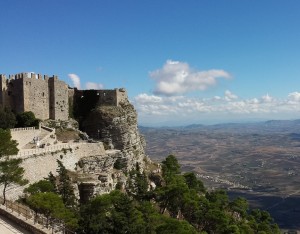On Sicily’s Streets, A View To Kill
It’s true in North America that anyone with a car can go anywhere. The open road is as much a symbol of freedom as it is a strip of asphalt devoid of traffic. A driver’s license forms the basis of identity.
Long a rite of passage and a popular midlife crisis trope, the likes of Jack Kerouac and John Steinbeck have cogitated on a journey of self-discovery made possible by the automobile.
“I discovered I did not know my own country,” wrote Steinbeck in Travels with Charley, explaining why he hit the road at the young age of 58. He was describing America, of course, which is quite a shame. If he really wanted to ruminate on the road, he should have written about Sicily.
The southern autonomous Italian region may not seem an ideal destination for a singular journey of self-discovery, and it’s not — at least not by oneself. For a truly memorable adventure — more Tommy Boy or Thelma & Louise than Into the Wild — a companion is an absolute necessity when traversing the largest island in the Mediterranean by five-seated steel horse.
Fortunately, I had just the companion in the form of Kesi, my Toronto-transplant flatmate back in Berlin. We were two young men in Italy for the first time, with time to spare and money to burn. What could possibly go wrong?
Standing on the docks in Palermo, it was a lukewarm morning, the type of fall day that refuses to acknowledge that summer has come to a close and so desperately tries to rekindle that warmth like a scorned lover. Kesi’s ship was due to arrive from Naples around 6:30 that morning and, sure enough, the massive vessel with four gaping garages for cars dropped the gangplank just a little behind schedule. Who said Italians were always late?
We quickly made our way on foot through Palermo’s relatively straight — and compared to some parts of southern Italy, relatively clean — streets and past shops from designer brands like Ermenegildo Zegna, Gucci and Louis Vuitton, to cozy local cafes serving up piping hot espresso and ice-cold gelato, before heading to Palermo Centrale, the Di Giovanni-designed railway station that serves as among the most important in the region. A quick bus transfer to Falcone-Borsellino Airport (named for two anti-mafia judges who were murdered in 1992) and the perfunctory paperwork that accompanies all car rentals and we were in the front of a newish dark gray Fiat 500, a two-door vehicle whose size would be laughable — and frankly, dangerous — on any North American highway. But here in Italy, where the waistlines are small and the cars smaller, it was as quintessential as spaghetti and meatballs.
Our destination was Erice, a small town on a mountain near Trapani dating back to roughly 460 BC. With roughly 90 kilometers (55 miles) between our present location and the new one, we had just enough time to get a feel for the open road in one of the southernmost locations in Europe closer to Tunisia than Rome.
Sun quickly rising high in the sky and sliding onto the A29 autostrada (Italian for “highway” or “expressway”), traffic was light as we put pedal to metal. Unlike certain stretches of the German Autobahn, Italian highways do have posted speed limits and signs constantly warning motorists that they are being electronically monitored to ensure their compliance. No one seemed to be paying attention, however; if a sign said 50 kilometers an hour (31 miles per hour), then it was acceptable to go 80 (49 MPH) — a “when in Italy” moment, apparently.
Sharp hills that looked like they belonged in an oil painting and an azure ocean bluer than the bluest dye framed a winding journey through picturesque town after picturesque town. Here was an olive grove and vineyard; there was a herd of sheep being tended by shepherds. It all seemed like a pastoral version of Southern California, at least before humanity arrived. Blasting the likes of Bruno Mars and Snoop Dogg from a stereo that boasted a surprisingly punchy base, one could almost believe this was an American road trip — almost.
It was our destination that gave it away. Zigzagging up a switchback road with heart-stopping drop-offs that put even the most terrifying rollercoasters to shame, we arrived at Erice, an area with a history going back to at least 460 BC.
“You come here to be here,” locals say of the walled town that crowns an imposing mountain 2,400 feet (730 meters) above the port city of Trapani. Simply being there, so to speak, is certainly a bucket-list experience. A mist-shrouded world cowled in gray stone, the narrow, winding cobbled streets and alleys of Erice that cut between houses, churches, and courtyard walls ensure one can quickly become lost both geographically and chronologically. Those stones, worn smooth by centuries of foot traffic, tell a story that makes the ancient town — at various times occupied by the Greeks, Carthaginians, Phoenicians, Romans, Arabs and Normans — among the most underrated in all of Europe. It was well-known throughout the Mediterranean in ancient times as a center of cult activity, where townspeople worshipped the goddess Venus at a now-ruined temple that at the time was among the largest in the region. In On the Nature of Animals, Aelian writes that animals chosen for sacrifice would voluntarily walk to the altar to be slaughtered.
(Article continued on next page)

